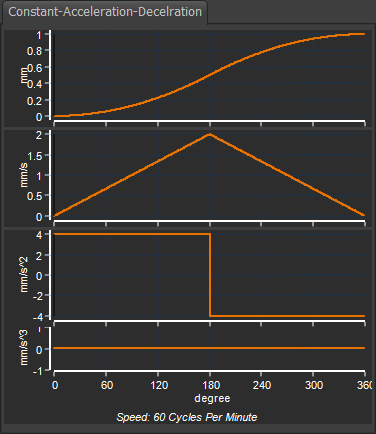The Constant-Acceleration motion-law was used in the past because it has the lowest nominal acceleration of the Traditional Motion-Laws. However, it has at three points: at its start, end, and at its . This makes it a very poor choice form a dynamic-response viewpoint. Infinite-Jerk incites vibrations in any mechanical system. We do not recommend this motion-law if the is less than 10, or even 20.
Dynamic Performance
The actual acceleration of a payload is significantly more than the nominal Constant-Acceleration value because of induced vibrations. For this reason, this motion-law should only be used in applications where inertia effects are insignificant.
Pressure-Angle Considerations
This motion-law produces a relatively large pressure-angle - and so might need a large cam for a given lift. The pressure-angle for this motion-l varies quite severely throughout this Motion-Law indicating that it is unsuitable for roller follower applications because of the severe accelerations imposed on the roller that induce roller slip.
Drive-Torques
This law performs badly in terms of drive torque considerations. This law has a discontinuity in Drive Torque, indicating shock loading and noise in operation. Particularly notable is the sudden reversal of the inertia torque factor, and hence of the torsional strain energy, at the crossover of the motion segment. These reversals contribute to noise, shock loading, and vibration during operation.
|
